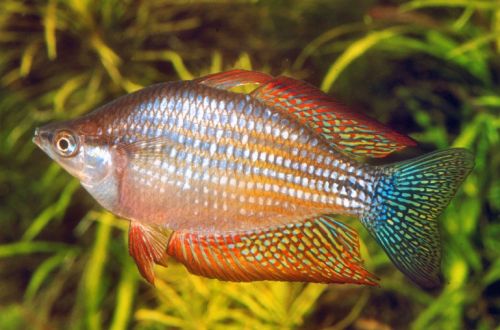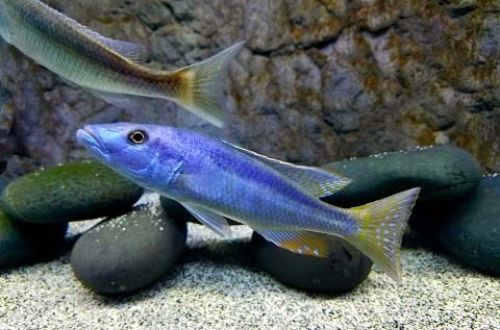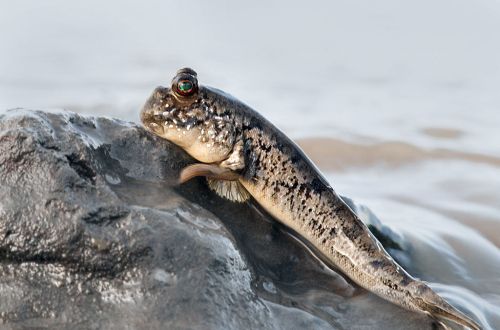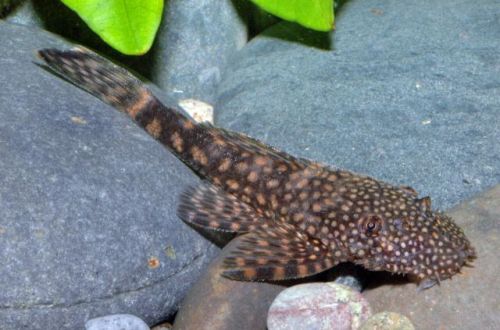
Cherry iris
Cherry melanothenia or cherry iris, scientific name Melanotaenia splendida inornata, belongs to the Melanotaeniidae family. It is unpretentious, easy to keep and breed, compatible with many other fish species, and also has a beautiful body color. All this makes it a good choice for the beginner aquarist.

Contents
Habitat
It comes from the Australian continent from a narrow “green” strip bordering the mainland, where tropical rainforests have been preserved. It lives in swamps, streams and slow-flowing rivers. Prefers regions with dense aquatic vegetation floating on the surface. Keeps close to the coast among the flooded trees, bushes.
Brief information:
- The volume of the aquarium – from 100 liters.
- Temperature – 26-33°C
- Value pH — 6.5–8.0
- Water hardness – soft to hard (8-20 dGH)
- Substrate type – any
- Lighting – subdued
- Brackish water – no
- Water movement – weak/absent
- The size of the fish is up to 15 cm.
- Food – any food
- Temperament – peaceful active
- Keeping a flock of at least 6-8 individuals
Description
A close relative of the Eastern Rainbow and Melanothenia red-striped. The fish are similar in appearance to each other, so they are often confused. Adults reach a length of up to 15 cm. The color is pink or red-orange with barely noticeable bluish horizontal stripes. The fins are bright with colorful dots, creating a single continuous pattern. Sexual dimorphism is weakly expressed. Males are somewhat larger than females and have larger dorsal and anal fins.
Food
Undemanding to the diet and nutritional composition. Accepts most popular foods (dry, frozen, live). It is advisable to combine different products. For example, flakes and granules should be served with bloodworms or brine shrimp. This diet will allow the fish to show their best colors.
Maintenance and care, decoration of the aquarium
The recommended volume of the aquarium for a small flock of fish starts from 100 liters. The design should form areas with dense vegetation, interspersed with open areas for swimming. Plants floating on the surface are welcome, they serve as an additional means of shading the aquarium. Any substrate, at the discretion of the aquarist and the needs of plants.
The cherry iris prefers a subdued level of lighting, does not respond well to internal flow and needs high water quality. Aquarium equipment should be selected based on these features/requirements. In many ways, the key to successful keeping is the acquisition of a productive filtration system and the regular replacement of part of the water (15–20% of the volume) with fresh water, which will maintain acceptable living conditions for these tropical fish.
Behavior and Compatibility
Active peaceful fish, compatible with other non-aggressive species of similar size. Excessive mobility of the Cherry Rainbow can adversely affect slower neighbors, so it is advisable to exclude them. Keeping in a flock of at least 6-8 individuals of both sexes.
Breeding / breeding
Raduzhnitsy breeding is possible both in general and in a separate spawning aquarium. Favorable conditions for the beginning of the mating season are achieved at a temperature of 27–30°C, in slightly alkaline (up to pH 7.0) water of medium hardness. The design should contain thickets of small-leaved plants or their artificial counterparts, among which there will be females that will lay eggs.
Spawning lasts about 2 weeks, during this time the female will lay several dozen eggs daily, and the male will fertilize them. Parental instincts are not developed, therefore, after the end of spawning, the fish do not show any interest in future offspring. If breeding was carried out in a common aquarium, then it is advisable to move the eggs to a separate tank with identical conditions. Otherwise, there is a great risk of them being eaten by other fish. In the absence of a spawning aquarium, dense clusters of floating plants can be purchased, which will serve as a reliable refuge for fry.
The incubation period lasts about 7-12 days. In the first days of life, fry are able to eat only microscopic food, for example, ciliates. After a week, Artemia nauplius or specialized powdered food for juvenile aquarium fish can be fed. It is worth noting that it is rather problematic to feed the Rainbow fry in a common aquarium than in a separate spawning one.
Fish diseases
Health problems arise only in case of injuries or when kept in unsuitable conditions, which depresses the immune system and, as a result, provokes the occurrence of any disease. In the event of the appearance of the first symptoms, first of all, it is necessary to check the water for the excess of certain indicators or the presence of dangerous concentrations of toxic substances (nitrites, nitrates, ammonium, etc.). If deviations are found, bring all values back to normal and only then proceed with treatment. Read more about symptoms and treatments in the Aquarium Fish Diseases section.





